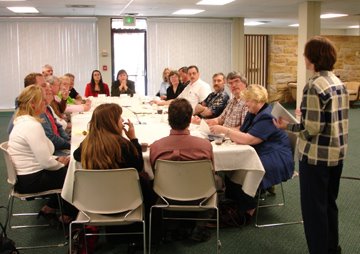15 September 2006
Conduct your own Focus Group
 You've just developed a new product, but you don't know if it matches people's expectations. So what do you do?
Focus groups have been so under-utilised in small businesses that it's time to turn the tide around.
What are focus groups?
Focus groups are carefully assembled groups consisting of members that have a common interest related to your product. They will give first hand opinions on your product and advise you on how to improve it.
Arranging for a focus group is easy if you follow the steps below:
1. Contact the right people
A typical focus group consists of 6-10 people who are relevant to your product. They should be willing to express thoughts and emotions without restraint , because the main objective of the group is to bare the truth.
If you're running women's apparel business, you should have at least 2 focus groups. The first should consist of potential customers (teenagers/adults depending on your product).
The second should consist of your sales people - because they need to understand the product and be confident that they can sell the apparel.
Depending on your objective, you can choose to expand your focus groups or even add more groups to include employees from other departments.
2. Arrange for the session
Once you get the green light, plan for the meeting. E-mail them the meeting agenda 1-2 days before the session.
What are you going to ask the focus groups? Get your questions ready and prepare for positive and negative feedback. Arrange for proper sitting and refreshments. Make the group feel appreciated to maximise your input. A typical focus group session would be introducing the product, giving the participants hands-on experience with it before asking them the prepared questions.
Most importantly, get a good moderator that appeals to the focus group so that he/she can keep the positive energy flowing in the group. In every successful event there must be a very good emcee. The same applies to focus groups!
3. Don't overprepare
A typical focus group session lasts 1 to 1.5 hours, but it does not mean you need to prepare every minute of the session. Instead, allow plenty of space for participants to voice their opinions, because the ultimate goal is to get feedback.
4. During the session
Anything can happen in a focus group, so get someone to note everything down ( an audio/video recorder might help). You might not have noticed a member suggesting a brilliant improvement to your product during the session, but you might catch in on tape!
5. After the session
Thank the participants of the focus group and tell them that a summary of their answers will be generated and sent to them. Follow-up with thank you gifts.
You've just developed a new product, but you don't know if it matches people's expectations. So what do you do?
Focus groups have been so under-utilised in small businesses that it's time to turn the tide around.
What are focus groups?
Focus groups are carefully assembled groups consisting of members that have a common interest related to your product. They will give first hand opinions on your product and advise you on how to improve it.
Arranging for a focus group is easy if you follow the steps below:
1. Contact the right people
A typical focus group consists of 6-10 people who are relevant to your product. They should be willing to express thoughts and emotions without restraint , because the main objective of the group is to bare the truth.
If you're running women's apparel business, you should have at least 2 focus groups. The first should consist of potential customers (teenagers/adults depending on your product).
The second should consist of your sales people - because they need to understand the product and be confident that they can sell the apparel.
Depending on your objective, you can choose to expand your focus groups or even add more groups to include employees from other departments.
2. Arrange for the session
Once you get the green light, plan for the meeting. E-mail them the meeting agenda 1-2 days before the session.
What are you going to ask the focus groups? Get your questions ready and prepare for positive and negative feedback. Arrange for proper sitting and refreshments. Make the group feel appreciated to maximise your input. A typical focus group session would be introducing the product, giving the participants hands-on experience with it before asking them the prepared questions.
Most importantly, get a good moderator that appeals to the focus group so that he/she can keep the positive energy flowing in the group. In every successful event there must be a very good emcee. The same applies to focus groups!
3. Don't overprepare
A typical focus group session lasts 1 to 1.5 hours, but it does not mean you need to prepare every minute of the session. Instead, allow plenty of space for participants to voice their opinions, because the ultimate goal is to get feedback.
4. During the session
Anything can happen in a focus group, so get someone to note everything down ( an audio/video recorder might help). You might not have noticed a member suggesting a brilliant improvement to your product during the session, but you might catch in on tape!
5. After the session
Thank the participants of the focus group and tell them that a summary of their answers will be generated and sent to them. Follow-up with thank you gifts.
0 comments:
Post a Comment